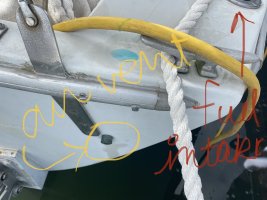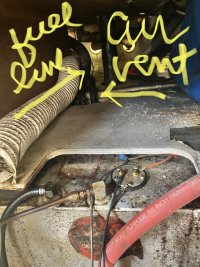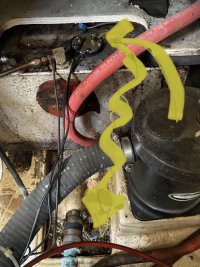halliealdrich
Member I
It started a few years ago when my boat destroyed its tether and ran aground, resting on the diesel intake side. I noticed some leakage and cleaned it up. A consult with help said that sometimes the diesel will flow out of air vent at that extreme angle, and apparently elsewhere since there was diesel in the bilge, five absorbency mats-worth. Fast forward a year, after joining the yacht club, where I had access to dockside workspace! I added diesel via the intake port, and in about 30 seconds the diesel started spitting out the air vent.
My club friend tightened all the connections to the tank. We thought that fixed it. I motored around between sailing stints without filling the tank since he said, after plunking the tank with his wrench, “oh that’s full!” (Note to self: when you know you haven’t filled the tank for five years ... why believe such nonsense) until I ran out of fuel. Guess what happened when filling.... spurtage from the air vent. And leakage from above— on top of the tank. We thought, clog? Yes, there was a clog! It was cleared by a wire through the intake line. Was there a leak after clearing the clog in the line, presumably from tank gunk that settled when aground a year before. Yes, a leak! I figured that there must have been a half cup of fuel above the leak, and it weaped out a failing connection when the clog dispersed. Then we inserted a smaller tube to go through the intake line to pass the tank connection (on top of tank), since that must be the leak location, which is very hard to access. Now we add diesel via mini pump action. Once again, now we have a very active air vent spurting fuel.
a couple observations:
-The leak starts about 30-60 seconds after filling begins
-the tank glistens on top first, then into bilge
-the last attempt, at the moment there was fuel spurting, there was a sucking sound from inside the tank, which then disappeared at approximately the air vent spurt began. (Only reason I can muster is that maybe the tube reached the very bottom, and new fuel was pumping into bottom gunk?)
questions:
Um, what about gravity and geometry??? The air vent connects to the tank right beside the intake, on the top of the tank.is the tank full? Empty? Pressurized? Is the air vent clogged (and how the hell do u clear that)? How could it be, it’s leaking fuel?
Solutions? Long term? Short term? Thank you for reading all the way to the end! I’d really like to sail this summer! New bottom paint and chart plotter/depth sounder and new cushions and curtains are going unused!
My club friend tightened all the connections to the tank. We thought that fixed it. I motored around between sailing stints without filling the tank since he said, after plunking the tank with his wrench, “oh that’s full!” (Note to self: when you know you haven’t filled the tank for five years ... why believe such nonsense) until I ran out of fuel. Guess what happened when filling.... spurtage from the air vent. And leakage from above— on top of the tank. We thought, clog? Yes, there was a clog! It was cleared by a wire through the intake line. Was there a leak after clearing the clog in the line, presumably from tank gunk that settled when aground a year before. Yes, a leak! I figured that there must have been a half cup of fuel above the leak, and it weaped out a failing connection when the clog dispersed. Then we inserted a smaller tube to go through the intake line to pass the tank connection (on top of tank), since that must be the leak location, which is very hard to access. Now we add diesel via mini pump action. Once again, now we have a very active air vent spurting fuel.
a couple observations:
-The leak starts about 30-60 seconds after filling begins
-the tank glistens on top first, then into bilge
-the last attempt, at the moment there was fuel spurting, there was a sucking sound from inside the tank, which then disappeared at approximately the air vent spurt began. (Only reason I can muster is that maybe the tube reached the very bottom, and new fuel was pumping into bottom gunk?)
questions:
Um, what about gravity and geometry??? The air vent connects to the tank right beside the intake, on the top of the tank.is the tank full? Empty? Pressurized? Is the air vent clogged (and how the hell do u clear that)? How could it be, it’s leaking fuel?
Solutions? Long term? Short term? Thank you for reading all the way to the end! I’d really like to sail this summer! New bottom paint and chart plotter/depth sounder and new cushions and curtains are going unused!





